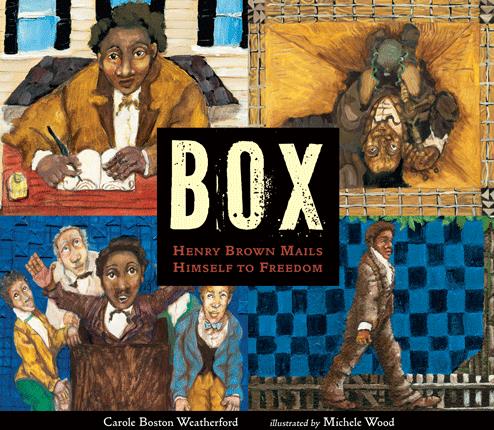| Box : Henry Brown mails himself to freedom Author: Weatherford, Carole Boston | ||
| Price: $23.08 | ||
Summary:
The life of a man who courageously shipped himself out of slavery.
| Illustrator: | Wood, Michele |
Video Preview:
| Accelerated Reader Information: Interest Level: MG Reading Level: 5.30 Points: .5 Quiz: 509048 |
Awards:
Newbery Honor, 2021
Reviews:
Kirkus Reviews (+) (03/01/20)
School Library Journal (+) (02/01/20)
Booklist (04/15/20)
The Bulletin of the Center for Children's Books (+) (00/05/20)
The Hornbook (+) (00/03/20)
Full Text Reviews:
School Library Journal - 02/01/2020 Gr 4 Up—Weatherford shares the story of Henry "Box" Brown, who was born into slavery in Richmond in the 1800s. Brown's birth family was divided after the death of their master. Later, Brown's pregnant wife and three children were sold and sent to North Carolina. In 1849, the same year Harriet Tubman escaped from slavery, Brown shipped himself in a wooden box to the American Anti-Slavery Society office in Philadelphia, successfully winning his freedom. Brown, given the nickname "Box" by abolitionists, promoted his escape by publishing an autobiography, Narrative of the Life of Henry Box Brown. He created a performance piece ("Mirror of Slavery") that he exhibited in the United States, England, and Canada, solidifying his place in American history. Brown's story is conveyed in a series of sixains (a poem of six lines), mirroring the six sides of a box. Each poem is deceptively simple, but Weatherford's lush storytelling allows Brown's voice and story to come through clearly. The imagery is often as brutal as the history itself, and Brown is portrayed as a nuanced and complex human being, willing to do what is necessary to survive. Wood's mixed-media illustrations are dynamic and engaging. The details urge a second or third reading of the text. Bibliography and notes from the author and illustrator are included. VERDICT An artful and introspective retelling of the life of a remarkable man and a painful era in U.S. history. Weatherford's text paired with Wood's illustrations combine to offer a memorable work of nonfiction.—Casey O'Leary, Meredith Nicholson School 96, IN - Copyright 2020 Publishers Weekly, Library Journal and/or School Library Journal used with permission.
Booklist - 04/15/2020 Geometry. How many sides to a box? This concrete poem, its words curling into the shape of the number six, opens an unusual and powerful book of poetry. Henry Box Brown, born enslaved in 1815 or 1816, famously had himself shut into a wooden crate in Virginia and mailed to freedom in Philadelphia. In a series of sixain poems, the author interprets Brown's autobiography, telling his story in urgent, compelling language. The love and comfort Brown finds with his wife, Nancy, and their children changes to despair when his family is sold and sent to another state. With little left to lose, he proceeds with the perilous escape. Mixed-media illustrations combine thickly textured figures and backgrounds, collage, and painted, folded paper to create images with three-dimensional qualities. As the illustrator says in her note, the pictures convey deep suffering, hope, and determination. Cubic shapes appear frequently, echoing and amplifying the six lines of each poem. Intended for older readers than Henry's Freedom Box (2007), the book artfully expresses difficult truths while being mindful of a child audience. - Copyright 2020 Booklist.
Booklist - 04/15/2020 - Copyright 2020 Booklist.



